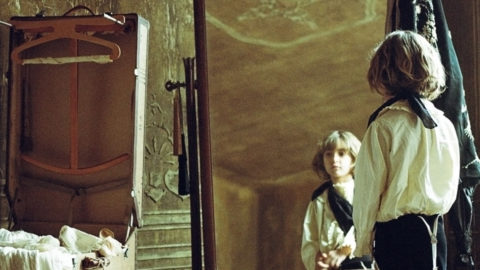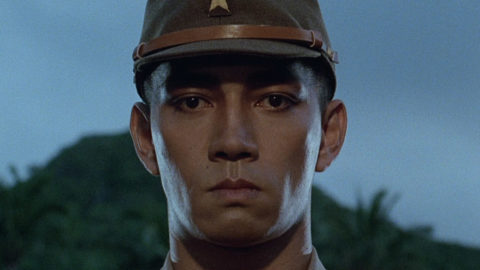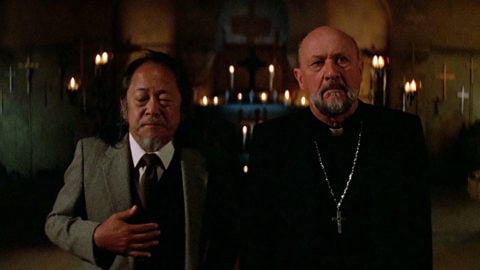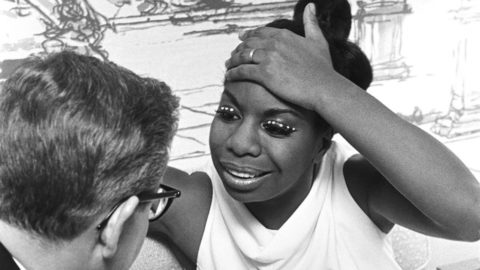Deep Cuts: Schmilsson on Screen
Some reading music: listen to this week’s special mix below. (See the full track listing.)
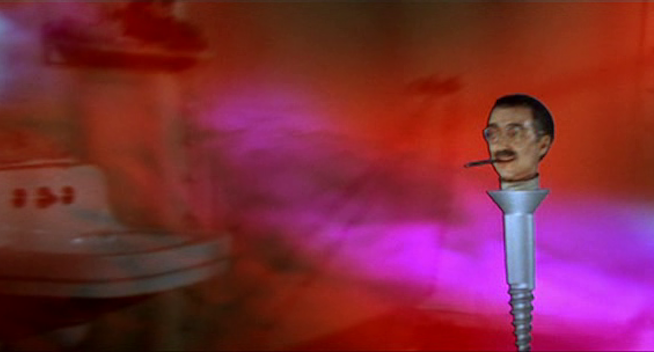
Skidoo
When asked to reveal their favorite artist and group at a 1968 press conference, John Lennon and Paul McCartney offered up the same curt answer: Nilsson. A singer/songwriter whom everyone has heard but few have heard of, Harry Nilsson achieved great success during his short career without performing in front of a live audience to promote his music, creating the so-called Nilsson mystique of success without widespread recognition. “Everybody’s Talkin’,” “Can’t Live,” “Coconut,” “One”—all of Nilsson’s major achievements were slightly off-center. His best-known vocal performances were covers of other people’s songs, while other musicians became popular singing his compositions.
Five films featuring Nilsson songs recently screened at BAM to commemorate the 75th anniversary of his birth in Brooklyn (his childhood home is located on Jefferson Avenue in Bedford Stuyvesant): Skidoo (1968), Midnight Cowboy (1969), The Point (1971), Son of Dracula (1974), and Popeye (1980) provide a concise sampling of some of Nilsson’s greatest hits and misses. But to gain insight into Nilsson the artist, there are a handful of televised performances that are currently available to watch on YouTube.
The earliest and most rare of these clips might be Nilsson’s performance on Hugh Hefner’s Playboy After Dark television show in 1968, to promote Skidoo with his director Otto Preminger (dressed in a shocking turquoise Nehru jacket and neck chains). Fidgety but charming, the 27-year-old Nilsson proves endearing with his original crooked teeth and Brooklyn accent, both overshadowed by his sweet, tuneful singing. His performance in front of a swinging, uncoordinated crowd of lecherous playboys and glassy-eyed women is accommodatingly hep as Nilsson, clad in black from head in mock turtleneck to toe, strikes an undeniably chic figure. Given his fear of public performance, he was certainly mortified in spite of his cheerful onstage banter and forgivably shoddy jokes.
“Everybody’s Talkin’,” originally recorded and written by folk singer Fred Neil, pushed Nilsson into the charts after it was featured prominently in John Schlesinger’s Midnight Cowboy. But when he was originally asked to submit a song for the soundtrack, Nilsson first offered “I Guess the Lord Must Be in New York City,” which he wrote especially for the film. “The Lord” describes the lead character’s move at the start of the film from Texas to New York City and is a better lyrical fit for the film’s opening sequence than “Everybody’s Talkin’,” which voices an opposing yearning for a sunny, uncomplicated locale away from the bustling city. Nilsson’s biographer Alyn Shipton describes the song as a kind of sequel to “Everybody’s Talkin’,” pointing out several parallels among the two compositions. George Tipton arranged both tracks and inserted a persistent banjo line throughout “The Lord” that is reminiscent of the 12-string finger-picking in “Everybody’s Talkin’,” but with an inherent southern twang. As it turned out, Schlesinger was predisposed to “Everybody’s Talkin’,” having used the song as a temp track during the shoot, and so rejected “The Lord” in favor of the Fred Neil cover. A clunky extended cut plays throughout the film’s opening sequence depicting Joe Buck’s migration to the big city, while Nilsson’s delicate performance gives Jon Voigt’s Buck an added vulnerability, softening his clumsy podunk facade. Nilsson had already released the song on his 1968 album Aerial Ballet, but the re-release proved to be a big hit, while “The Lord” was eventually used on the soundtrack to Mortadella (or Lady Liberty, 1971), starring Sophia Loren, and included on Nilsson’s Harry album in 1969.
Many high-profile artists and musicians took notice of Nilsson’s breakout album Pandemonium Shadow Show in 1967, and John Schlesinger was not the only director to approach him about contributing to a soundtrack. Preminger asked him to score Skidoo around the same time, marking Nilsson’s first film project. Wildly off the mark, Skidoo is a wacky comedy about ’60s counterculture starring a cast of eminent middle-aged stars, in which an ex-gangster (played by Jackie Gleason) is brought back into the fold by his superior (Groucho Marx) and forced to infiltrate a prison in order to murder his old friend (Mickey Rooney). Preminger reportedly dropped acid to prepare for the film and hired about two hundred hippies on loan from a San Francisco commune to round out the cast. Nilsson’s music hall–style tunes hew closer to the squares than to the freaks, while Carol Channing’s performance of his title theme sounds as if it were tailor-made for jazz hands and lazy can-can kicks—hardly indicative of the swinging ’60s.
In 1970 Nilsson performed to an unseen audience on The Smothers Brothers Summer Show, soon after the release of Midnight Cowboy and before the debut of the animated feature The Point. He sang his “rejected” song “I Guess the Lord Must Be in New York City” with one of the brothers, and previewed a beautifully stripped-down version of the song “Think About Your Troubles” from The Point. Throughout his brief appearance on the show, he makes wonderful use of his three-and-a-half-octave vocal range, hitting one high note after another in his angelic, unwavering falsetto.
Developed for Nilsson House Productions, The Point tells the story of Oblio, the “pointless” round-headed boy in a village populated by pointy-headed, narrow minded people. Nilsson reportedly came up with the premise after he experienced an LSD-enhanced epiphany while walking his dog through the point-tipped woods near his home. The Point became the first animated Sunday Movie of the Week on ABC, animated and directed by Fred Wolf, and the original version with narration by Dustin Hoffman (instead of Ringo Starr) is available on YouTube.
Nilsson’s influence is stamped all over the film, from the precious humor to the drugged-out psychedelic sequences. Fred Wolf’s vibrating, hand-drawn animations work well with Nilsson’s subtly haywire songwriting which happens to uncannily correspond to his larger body of work. A child ventures out on his own, just as Nilsson did himself at 15 years old, while the lyrics to the song “Life Line” nod ahead to one of Nilsson’s later songs, as the boy ponders the dark recesses of a deep pit. Nilsson’s lyrics about “going down,” made weightless with heavenly orchestration, elucidate a terrifying concept that he will repeat later in the song “Down,” on both Nilsson Schmilsson and the Son of Dracula soundtrack.
After The Point, Nilsson allowed producer Stanley Dorfman to film him for his In Concert television series in 1971 under one condition: that the “concert” be filmed without a live audience. Dorfman not only consented to the demand, he complied with Nilsson’s suggestion that they film comedic interludes with a phony audience and utilized multiple exposures to show three Harrys singing together in harmony, visually demonstrating Nilsson’s favorite post-production technique of overdubbing his own voice with multiple tracks. Nilsson’s singing in the completed program is pitch-perfect and his vocal improvisations are transcendent, displaying a rare immediacy hitherto unknown to fans of his recorded albums.
In 1971 Nilsson released his follow-up to his most successful album, Nilsson Schmilsson, titled Son of Schmilsson (1971). The album featured Ringo Starr on drums and soon after the recording, Starr, in his capacity as producer and newly minted head of Apple Films, invited Nilsson to play the lead role in Freddie Francis’s Son of Dracula, then titled Count Downe. As the half-human son of Count Dracula, Nilsson is stiff and distracted but is nowhere near as horrendously deadpan as Starr in his role as Merlin the Magician, acting unintentionally as if he were under hypnosis. Francis did what he could with the unruly cast and made a valiant effort with some now-outdated camera tricks, animation, and decorative lighting and set design, but the film is nonetheless an amusing mess. The soundtrack includes some of Nilsson’s best songs, such as “Jump Into the Fire,” “Down,” and the power ballad “Without You,” and his impressive on-screen backing band includes John Bonham and Keith Moon alternating on drums, along with Peter Frampton, Leon Russell, Klaus Voorman, and others, pounding away on their instruments to a crowd of intoxicated ghouls at an underworld nightclub.
The permanent party scene on the set of Son of Dracula was such that hardly anyone involved can remember its filming. 1974 was also the year of the release of the Pussy Cats album, a time capsule of Nilsson’s destructive relationship with John Lennon during the latter’s so-called “Lost Weekend” period of heavy drinking and drugging. Nilsson ruptured one of his vocal chords during a recording session for the album as he and Lennon tried their best to out-scream each other. Nilsson’s voice never fully recovered from the incident and the roughness of his vocals were amplified in every recording since.
Nilsson knew that his lifestyle was seriously impinging his voice, and so in 1973, just before the recording of the Pussy Cats album, he recorded A Little Touch of Schmilsson in the Night—a fully orchestrated collection of standards, to preserve his voice on record while he was still able to hit all of the correct notes. The accompanying “concert” film (again, there was no audience) again produced by Stanley Dorfman, is also available to watch in its entirety on YouTube with Nilsson and the orchestra drinking and smoking between takes.
After Son of Dracula, Nilsson’s next major film project was Popeye (1980), Robert Altman’s characteristically ramshackle live-action rendition of the 1930s cartoon. Nilsson himself does not sing on the soundtrack but the cast of professional actors/amateur singers instead attempt skeletal versions of his songs. Robin Williams’ anemic singing as Popeye through teeth gritted over a corncob pipe just intimates Nilsson’s melodic charm, while Shelley Duvall as Olive Oyl and Paul L. Smith as Bluto butcher his music by straying miles out of tune. With unusually minimal arrangements by Van Dyke Parks, the songs all tumble onto the soundtrack without warning, ambling along with the cast’s purposeful talk-singing. There is much to enjoy in the film; Williams peregrinates and mumbles like a true Altmanite, while the humongous set is conversely magnificent. Unfortunately, even those reviews that favored the film (and there were a few) wrote disdainfully of the score, and Nilsson never composed another soundtrack again.
Following Lennon’s death that same year, Nilsson became an advocate for gun control and made occasional appearances in support of the cause. In 1984, he did the unthinkable and sang in front of a live audience at Beatlefest, though he was visibly discombobulated with a drink in hand. After fumbling his way through a medley of Beatles songs he appeared to exit the stage early, much to the confusion of the backing musicians on stage.
The sloppiness of Nilsson’s latter years assigns all the more value to his earlier recorded performances; his few television appearances and the two feature-length concerts produced by Stanley Dorfman. The richness of his voice and vocal range does not come through as effectively on his records as it did in his live performances, where he was able to fully express his profound connection with the music and lyrics. Nilsson was by all accounts a frequently troubled man, though also kind, charming, and singularly talented. This all emerges in his facial expressions and delicate mannerisms of his televised performances, showing him to be simultaneously awkward and assured in his own talent.
Track List:
1. Jump into the Fire – Son of Dracula
2. Gotta Get Up – Nilsson Schmilsson
3. Everybody’s Talkin’ – Aerial Ballet
4. I Guess the Lord Must Be in New York City – Harry
5. Vine St. – Nilsson Sings Newman
6. Love Story – Nilsson Sings Newman
7. Si no estas tú (Spanish version of Without You)
8. Life Line – The Point!
9. Down – Son of Dracula
10. You Can’t Do That (remixed) – Aerial Pandemonium Ballet
11. Think About Your Troubles – The Point!
12. One – Aerial Ballet
13. Me & My Arrow – The Point!
14. I Will Take You There – Skidoo
15. 1941 (remixed) – Aerial Pandemonium Ballet
16. Living Without You – Nilsson Sings Newman
Margaret Barton-Fumo is the editor of a forthcoming book on Paul Verhoeven and a longtime contributor to Film Comment.



